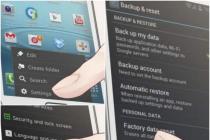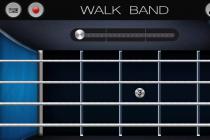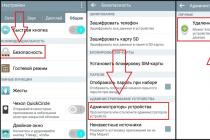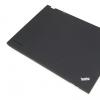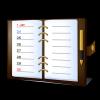With the rise in electricity prices, one has to think about more economical lamps. Some of these use daylight lighting. The connection diagram for fluorescent lamps is not too complicated, so even without special knowledge of electrical engineering you can figure it out.
Good illumination and linear dimensions - the advantages of daylight
The principle of operation of a fluorescent lamp
Daylight fixtures use the ability of mercury vapor to emit infrared waves when exposed to electricity. In the range visible to our eyes, this radiation is transferred by phosphor substances.
Therefore, an ordinary fluorescent lamp is a glass bulb, the walls of which are covered with a phosphor. There is also some mercury inside. There are two tungsten electrodes providing electron emission and heating (vaporization) of mercury. The flask is filled with an inert gas, most often argon. Glow begins when mercury vapor is heated to a certain temperature.

But for the evaporation of mercury, normal mains voltage is not enough. To start work, in parallel with the electrodes, start-regulating devices (abbreviated as ballast) are turned on. Their task is to create a short-term voltage surge necessary for the onset of glow, and then limit the operating current, preventing its uncontrolled increase. These devices - ballasts - are of two types - electromagnetic and electronic. Accordingly, the schemes are different.
Starter circuits
The very first circuits with starters and chokes appeared. These were (and in some versions are) two separate devices, each of which had its own socket. There are also two capacitors in the circuit: one is connected in parallel (to stabilize the voltage), the second is located in the starter housing (increases the duration of the starting pulse). All this "economy" is called electromagnetic ballast. A diagram of a fluorescent lamp with a starter and a choke is shown in the photo below.

Connection diagram for fluorescent lamps with a starter
This is how it works:
- When the power is turned on, the current flows through the inductor and goes to the first tungsten coil. Further, through the starter, it enters the second spiral and leaves through the zero conductor. At the same time, the tungsten filaments gradually heat up, as do the starter contacts.
- The starter consists of two contacts. One is fixed, the second is movable bimetallic. They are normally open. When current flows, the bimetallic contact heats up, which leads to the fact that it bends. Bent over, it connects to a fixed contact.
- As soon as the contacts are connected, the current in the circuit instantly rises (2-3 times). It is limited only by the throttle.
- Due to a sharp jump, the electrodes are heated very quickly.
- The bimetallic plate of the starter cools down and breaks the contact.
- At the moment of contact breakage, a sharp voltage jump occurs across the inductor (self-induction). This voltage is enough for the electrons to break through the argon medium. Ignition occurs and gradually the lamp enters the operating mode. It occurs after all the mercury has evaporated.
The operating voltage in the lamp is lower than the mains voltage for which the starter is designed. Therefore, after ignition, it does not work. In a working lamp, his contacts are open and he does not participate in its work in any way.
This circuit is also called electromagnetic ballast (EMB), and the operating circuit of the electromagnetic ballast is called EMCP. This device is often referred to simply as a choke.

One of the EMPRA
The disadvantages of this scheme for connecting a fluorescent lamp are enough:
- pulsating light, which negatively affects the eyes and they quickly get tired;
- noises during start-up and operation;
- impossibility of starting at a low temperature;
- long start - from the moment of switching on, about 1-3 seconds pass.
Two tubes and two chokes
In luminaires for two fluorescent lamps, two sets are connected in series:
- the phase wire is fed to the choke input;
- from the output of the throttle goes to one contact of the lamp 1, from the second contact goes to the starter 1;
- from the starter 1 goes to the second pair of contacts of the same lamp 1, and the free contact is connected to the zero power wire (N);
The second tube is also connected: first the throttle, from it - to one contact of the lamp 2, the second contact of the same group goes to the second starter, the starter output is connected to the second pair of contacts of the lighting device 2 and the free contact is connected to the zero input wire.

Connection diagram for two fluorescent lamps
The same connection diagram for a two-lamp daylight lamp is shown in the video. It may be easier to deal with the wires this way.
Wiring diagram for two lamps from one choke (with two starters)
Practically the most expensive in this circuit are chokes. You can save money and make a two-lamp luminaire with one choke. How - see the video.
Electronic ballast
All the shortcomings of the scheme described above stimulated research. As a result, an electronic ballast circuit was developed. It does not transmit the mains frequency of 50Hz, but high-frequency vibrations (20-60 kHz), thereby removing the blinking light, which is very unpleasant for the eyes.

One of the electronic ballasts - electronic ballasts
The electronic ballast looks like a small block with removed terminals. Inside there is one printed circuit board on which the entire circuit is assembled. The unit has small dimensions and is mounted in the body of even the smallest luminaire. The parameters are selected so that the start-up is quick, silent. No more devices are needed to work. This is the so-called non-starter switching circuit.
Each device has a diagram on the back. From it it is immediately clear how many lamps are connected to it. The information is also duplicated in the labels. Indicates the power of the lamps and their number, as well as the technical characteristics of the device. For example, the block in the photo above can only serve one lamp. Its connection diagram is on the right. As you can see, there is nothing complicated. Take the wires, connect them with conductors with the indicated contacts:
- connect the first and second contacts of the block output to one pair of lamp contacts:
- serve the third and fourth for another pair;
- supply power to the entrance.
Everything. The lamp is working. The circuit for switching on two fluorescent lamps to electronic ballasts is not much more complicated (see the diagram in the photo below).

The advantages of electronic ballasts are described in the video.
The same device is mounted in the base of fluorescent lamps with standard sockets, which are also called "economical lamps". This is a similar lighting fixture, only greatly modified.

Fluorescent lamps are connected in accordance with a slightly more complex scheme compared to their closest "relatives" - incandescent lamps. To ignite fluorescent-type lamps, starting devices must be included in the circuit, the quality of which directly affects the service life of the lamps.
To understand the features of the circuits, it is necessary first of all to study the device and mechanism of action of such devices.
Briefly about the features of the lamps

Each of these devices is a sealed flask filled with a special mixture of gases. At the same time, the mixture is designed in such a way that much less energy was spent on the ionization of gases compared to ordinary incandescent lamps, which makes it possible to noticeably on lighting.
In order for a fluorescent lamp to constantly give light, a glow discharge must be maintained in it. To ensure this, the required voltage is supplied to the electrodes of the bulb. The main problem is that a discharge can appear only when a voltage is applied that is significantly higher than the operating voltage. However, lamp manufacturers have successfully solved this problem as well.
Electrodes are installed on both sides of the fluorescent lamp. They take on the voltage, thanks to which the discharge is maintained. Each electrode has two contacts. A current source is connected to them, due to which the space surrounding the electrodes is heated.
Thus, the fluorescent lamp ignites after warming up its electrodes. To do this, they are exposed to a high-voltage pulse, and only then the operating voltage comes into play, the value of which must be sufficient to maintain the discharge.
| Luminous flux, lm | LED lamp, W | Contact luminescent lamp, W | Incandescent lamp, W |
|---|---|---|---|
| 50 | 1 | 4 | 20 |
| 100 | 5 | 25 | |
| 100-200 | 6/7 | 30/35 | |
| 300 | 4 | 8/9 | 40 |
| 400 | 10 | 50 | |
| 500 | 6 | 11 | 60 |
| 600 | 7/8 | 14 | 65 |
Under the influence of the discharge, the gas in the flask begins to emit ultraviolet light, which is imperceptible to the human eye. To make the light visible to a person, the inner surface of the bulb is covered with a phosphor. This substance provides a shift in the frequency range of light into the visible spectrum. By changing the composition of the phosphor, the gamut of color temperatures also changes, which ensures a wide range of fluorescent lamps.
Fluorescent lamps, unlike simple incandescent lamps, cannot simply be plugged into the electrical network. For the appearance of an arc, as noted, the electrodes must warm up and a pulse voltage must appear. These conditions are provided with the help of special ballasts. The most widely used ballasts of electromagnetic and
Fluorescent lamp prices
Classic connection via electromagnetic ballast
Features of the scheme
In accordance with this diagram, a choke is included in the circuit. Also, a starter is always included in the circuit.
Starter for fluorescent lamps - Philips Ecoclick StartersS10 220-240V 4-65WThe latter is a low-power neon light source. The device is equipped with bimetallic contacts and is powered from the mains with variable current values. The choke, starter contacts and electrode filaments are connected in series.
Instead of a starter, an ordinary button from an electric call can be included in the circuit. In this case, the voltage will be supplied by holding the bell button down. The button must be released after lighting the lamp.
The procedure for the scheme with electromagnetic ballast is as follows:
- after being connected to the network, the choke begins to accumulate electromagnetic energy;
- electricity is supplied through the starter contacts;
- the current rushes along the tungsten filaments of heating the electrodes;
- electrodes and starter are hot;
- the starter contacts open;
- the energy accumulated by the throttle is released;
- the voltage across the electrodes changes;
- a fluorescent lamp gives light.
In order to increase the efficiency and reduce the noise arising during the switching on of the lamp, the circuit is equipped with two capacitors. One of them (the smaller one) is located inside the starter. Its main function is to extinguish sparks and improve the neon pulse.
Among the key advantages of a circuit with an electromagnetic type ballast are:
- time-tested reliability;
- simplicity;
- affordable cost.
- As practice shows, there are more disadvantages than advantages. Among them it is necessary to highlight:
- the impressive weight of the lighting fixture;
- long time of switching on the luminaire (on average up to 3 seconds);
- low efficiency of the system when operating in the cold;
- relatively high energy consumption;
- noisy throttle operation;
- flicker that negatively affects vision.
Connection procedure
The connection of the lamp according to the considered scheme is carried out with the use of starters. Next, we will consider an example of installing one lamp with the inclusion of a starter model S10 in the circuit. This state-of-the-art device has a non-flammable housing and high-quality construction, making it the best in its niche.
The main tasks of the starter are reduced to:
- ensuring that the lamp is turned on;
- breakdown of the gas gap. For this, the circuit is broken after a rather long heating of the lamp electrodes, which leads to the release of a powerful pulse and direct breakdown.
The choke is used to perform the following tasks:
- limiting the magnitude of the current at the moment of closing the electrodes;
- generating a voltage sufficient for gas breakdown;
- maintaining the discharge burning at a constant stable level.
In this example, a 40 W lamp is connected. In this case, the choke must have the same power. The power of the starter used is 4-65 W.
We connect in accordance with the presented diagram. To do this, do the following.
First step
In parallel, we connect the starter to the pin side contacts at the output of the fluorescent lamp. These contacts are the leads of the sealed bulb filaments.
Second step
We connect to the remaining free contacts.
Third step
We connect the capacitor to the power contacts, again, in parallel. Thanks to the capacitor, reactive power will be compensated and interference in the network will be reduced.
Connection via modern electronic ballast
Features of the scheme
Modern connection option. An electronic ballast is included in the circuit - this economical and improved device provides a much longer service life of fluorescent lamps compared to the above option.
In circuits with electronic ballast, fluorescent lamps operate at increased voltage (up to 133 kHz). Thanks to this, the light turns out to be even, without flicker.
Modern microcircuits make it possible to assemble specialized launchers with low power consumption and compact dimensions. This makes it possible to place the ballast directly into the lamp base, which makes it possible to manufacture small-sized lighting fixtures that screw into a common holder, standard for incandescent lamps.
At the same time, the microcircuits not only provide the lamps with power, but also smoothly heat the electrodes, increasing their efficiency and increasing their service life. It is these fluorescent lamps that can be used in conjunction with - devices designed to smoothly control the brightness of light bulbs. You cannot connect a dimmer to fluorescent lamps with electromagnetic ballasts.
By design, the electronic ballast is a voltage converter. A miniature inverter converts DC to HF and AC. It is he who enters the electrode heaters. With increasing frequency, the intensity of heating the electrodes decreases.
The switching on of the converter is organized in such a way that at first the frequency of the current is at a high level. The fluorescent lamp, in this case, is included in the circuit, the resonant frequency of which is much lower than the initial frequency of the converter.
Further, the frequency begins to gradually decrease, and the voltage across the lamp and the oscillatory circuit increases, due to which the circuit approaches resonance. The heating intensity of the electrodes also increases. At some point, conditions are created that are sufficient to create a gas discharge, as a result of which the lamp begins to give light. The lighting device closes the circuit, the operating mode of which is changed at the same time.
When using electronic ballasts, the lamp connection diagrams are designed in such a way that the control device has the ability to adapt to the characteristics of the light bulb. For example, after a certain period of use, fluorescent lamps require a higher voltage to generate an initial discharge. Ballast will be able to accommodate such changes and provide the required quality of lighting.
Thus, among the many advantages of modern electronic ballasts, the following points should be highlighted:
- high efficiency of operation;
- gentle heating of the electrodes of the lighting device;
- smooth turning on of the light bulb;
- no flicker;
- the ability to use in low temperatures;
- self-adaptation to the characteristics of the luminaire;
- high reliability;
- light weight and compact size;
- increase in the service life of lighting fixtures.
There are only 2 disadvantages:
- complicated connection diagram;
- higher requirements for the correct installation and the quality of the components used.
Prices for electronic ballasts for fluorescent lamps
Electronic ballast for fluorescent lamps
Connection procedure
All necessary connectors and wires usually come with an electronic ballast. You can familiarize yourself with the connection diagram in the presented image. Also, suitable diagrams are given in the instructions for ballasts and directly lighting devices.
In such a scheme, the lamp is included in 3 main stages, namely:
- the electrodes are warmed up, due to which a more gentle and smooth start is ensured and the resource of the device is preserved;
- a powerful impulse is created, which is required for ignition;
- the operating voltage is stabilized, after which the voltage is applied to the luminaire.
Modern lamp connection schemes eliminate the need for a starter. This eliminates the risk of ballast burnout in the event of starting without a lamp installed.
Special attention should be paid to the connection diagram of two fluorescent bulbs at once to one ballast. The devices are connected in series. To complete the work, you need to prepare:
- induction choke;
- starters in the amount of two pieces;
- directly fluorescent lamps.
Connection sequence
First step. A starter is connected to each light bulb. The connection is parallel. In this example, the starter is connected to the pin output from both ends of the lighting fixture.
Second step. Free contacts are connected to the mains. In this case, the connection is made in series, by means of a choke.
Third step. Capacitors are connected in parallel to the contacts of the lighting fixture. They will reduce the severity of interference in the power grid and compensate for the reactive power that occurs.
An important point! In ordinary household switches, especially for budget models, contacts can stick under the influence of increased starting currents. In view of this, for use in combination with fluorescent lighting fixtures, it is recommended to use only high-quality specially designed for this.
You have familiarized yourself with the features of different schemes for connecting fluorescent lamps and now you can independently cope with the installation and replacement of such lighting devices.
Happy work!
Video - Connection diagram of fluorescent lamps
We offer two options for connecting fluorescent lamps, without using a choke.
Option 1.
All fluorescent luminaires powered by an alternating current (except for luminaires with high-frequency converters) emit a pulsating (with a frequency of 100 pulsations per second) luminous flux. This has a tiring effect on people's vision, distorts the perception of rotating nodes in mechanisms.
The proposed luminaire is assembled according to the well-known rectified current power supply scheme for a fluorescent lamp, characterized by the introduction of a large-capacity capacitor of the K50-7 brand into it to smooth out pulsations.
When you press the common button (see diagram 1), a 5V1 pushbutton switch is triggered, connecting the lamp to the mains, and a 5V2 button, which closes the glow circuit of the LD40 fluorescent lamp with its contacts. When the keys are released, the 5B1 switch remains on, and the SB2 button opens its contacts, and the lamp ignites from the emerging EMF of self-induction. When the button is pressed again, the switch SВ1 opens its contacts, and the lamp goes out.
I do not give a description of the switching device because of its simplicity. For uniform wear of the filaments of the lamp, the polarity of its switching on should be changed after about 6000 hours of operation. The luminous flux emitted by the lamp has practically no pulsations.
Scheme 1. Connections of a fluorescent lamp with a burnt filament (option 1.)
Even lamps with one burnt-out filament can be used in such a lamp. To do this, its terminals are closed on the base with a spring made of a thin steel string, and the lamp is inserted into the lamp so that a "plus" of the rectified voltage (the upper thread in the diagram) flows to the closed legs.
Instead of a capacitor of the KSO-12 brand for 10,000 pF, 1000 V, a capacitor from a failed starter for LDS can be used.
Option 2.
The main reason for the failure of fluorescent lamps is the same as for incandescent lamps - the burnout of the filament. For a standard luminaire, a fluorescent lamp with this kind of malfunction is of course unsuitable and must be thrown away. Meanwhile, according to other parameters, the resource of a lamp with a burned-out filament often remains far from being worked out.
One of the ways to "reanimate" fluorescent lamps is the use of cold (instant) ignition. For this, at least one of the cathodes must be
get along with the emission activity (see the scheme that implements the specified method).
The device is a diode-capacitor multiplier with a factor of 4 (see diagram 2). The load is a circuit of a series-connected gas-discharge lamp and an incandescent lamp. Their powers are the same (40 W), the nominal supply voltages are also close in magnitude (103 and 127 V, respectively). Initially, when a 220 V AC voltage is applied, the device works as a multiplier. As a result, a high voltage is applied to the lamp, which provides a "cold" ignition.

Scheme 2. Another option for connecting a fluorescent lamp with a burnt-out filament.
After the occurrence of a stable glow discharge, the device switches to the mode of a full-wave rectifier loaded with an active resistance. The effective voltage at the output of the bridge circuit is practically equal to the mains voltage. It is distributed between lamps E1.1 and E1.2. An incandescent lamp acts as a current-limiting resistor (ballast) and at the same time it is used as a lighting lamp, which increases the efficiency of the installation.
Note that the fluorescent lamp is actually a kind of powerful zener diode, so that changes in the supply voltage value affect mainly the glow (brightness) of the incandescent lamp. Therefore, when the mains voltage is characterized by increased instability, the E1_2 lamp must be taken with a power of 100 W for a voltage of 220 V.
The combined use of two different types of light sources, complementing each other, leads to an improvement in the lighting characteristics: the pulsations of the luminous flux are reduced, the spectral composition of the radiation is closer to natural.
The device does not exclude the possibility of using it as a ballast and a typical choke. It is connected in series at the input of the diode bridge, for example, in an open circuit instead of a fuse. When replacing the D226 diodes with more powerful ones - the KD202 series or the KD205 and KTs402 (KTs405) blocks, the multiplier allows you to power fluorescent lamps with a power of 65 and 80 W.
A properly assembled device does not require adjustment. In the case of a fuzzy ignition of a glow discharge, or in the absence of one at all, at the nominal mains voltage, the polarity of the connection of the fluorescent lamp should be changed. It is first necessary to make a selection of burned-out lamps to identify the possibility of working in this luminaire.
The luminescent lamp was invented in the 1930s as a light source, and has gained popularity and distribution since the late 1950s.
Its advantages are undeniable:
- Durability.
- Maintainability
- Profitability.
- Warm, cool and colored glow.
Long service life is ensured by a properly designed device for starting and regulating operation.
Industrial luminaireLDS (fluorescent lamp) is much more economical than the usual incandescent light bulb, however, an LED device of a similar power surpasses the luminescent one in this indicator.
Over time, the luminaire stops starting up, blinks, "hums", in a word, does not go into normal mode. Staying and working indoors becomes hazardous to human eyesight.
To remedy the situation, they try to turn on a knowingly working LDS.
If a simple replacement did not give positive results, a person who does not know how a fluorescent lamp works, comes to a dead end: "What to do next?" We will consider what parts to buy in the article.
Briefly about the features of the lamp
LDS refers to gas-discharge light sources of low internal pressure.
The principle of operation is as follows: The sealed glass body of the device is filled with inert gas and low pressure mercury vapor. The inner walls of the flask are covered with a phosphor. Under the influence of an electric discharge that occurs between the electrodes, the mercury composition of the gas begins to glow, generating ultraviolet radiation invisible to the eye. It, acting on the phosphor, causes a luminescence in the visible range. By changing the active composition of the phosphor, cold or warm white and colored light is obtained.
 LDS working principle
LDS working principle 
Expert opinion
Alexey Bartosh
Ask an expertBactericidal devices are designed in the same way as LDS, but the inner surface of the flask made of quartz sand is not covered with a phosphor. Ultraviolet light is freely emitted into the surrounding space.
Connection using electromagnetic ballast or electronic ballast
The structural features do not allow connecting the LDS directly to the 220 V network - operation from this voltage level is impossible. To start, a voltage of at least 600V is required.
With the help of electronic circuits, it is necessary to provide the required operating modes one after another, each of which requires a certain voltage level.
Operating modes:
- ignition;
- glow.
Triggering consists in applying high voltage pulses (up to 1 kV) to the electrodes, as a result of which a discharge occurs between them.
Certain types of control gear, before starting, heat the spiral of the electrodes. Glowing makes it easier to start the discharge, while the filament overheats less and lasts longer.
After the luminaire is on, the power is supplied with alternating voltage, and the energy-saving mode is activated.
 Connection using electronic ballasts
Connection using electronic ballasts  connection diagram
connection diagram In devices manufactured by the industry, two types of ballasts are used:
- electromagnetic control gear EMPRA;
- electronic ballast - electronic ballast.
The diagrams provide for a different connection, it is presented below.
Scheme with EMPRA
 Connection using EMPRA
Connection using EMPRA The electrical circuit of a luminaire with electromagnetic control gear (EMPRA) includes the following elements:
- throttle;
- starter;
- compensating capacitor;
- Fluorescent Lamp.
 switching circuit
switching circuit At the moment of power supply through the circuit: throttle - LDS electrodes, voltage appears on the contacts of the starter.
The bimetallic contacts of the starter, which are in the gaseous environment, are closed when heated. Because of this, a closed loop is created in the lamp circuit: 220 V contact - choke - starter electrodes - lamp electrodes - 220 V contact.
The electrode filaments, when heated, emit electrons, which create a glow discharge. Part of the current begins to flow through the circuit: 220V - choke - 1st electrode - 2nd electrode - 220 V. The current in the starter drops, the bimetallic contacts open. According to the laws of physics, at this moment there is an EMF of self-induction at the contacts of the choke, which leads to the appearance of a high-voltage pulse on the electrodes. A breakdown of the gas medium occurs, an electric arc arises between the opposite electrodes. The LDS starts to glow with an even light.
Subsequently, a choke connected to the line provides a low level of current flowing through the electrodes.
The choke connected to the AC circuit acts as an inductive reactance, reducing the efficiency of the luminaire by up to 30%.
Attention! In order to reduce energy losses, a compensating capacitor is included in the circuit, without it the luminaire will work, but power consumption will increase.
Circuit with electronic ballasts
Attention! In retail, electronic ballasts are often found under the name electronic ballast. The name of the driver is used by sellers to refer to power supplies for LED strips.
 Appearance and device of electronic ballasts
Appearance and device of electronic ballasts The appearance and arrangement of an electronic ballast designed to turn on two lamps, each with a power of 36 watts.

Expert opinion
Alexey Bartosh
Specialist in repair, maintenance of electrical equipment and industrial electronics.
Ask an expertImportant! It is forbidden to turn on electronic ballasts without a load in the form of fluorescent lamps. If the device is designed to connect two LDS, it cannot be used in a single circuit.
In circuits with electronic ballasts, the physical processes remain the same. Some models are designed to preheat the electrodes to extend the life of the lamp.
 ECG type
ECG type The figure shows the appearance of electronic ballasts for devices of different power.
The dimensions allow placing electronic ballasts even in the E27 base.
 ECG in the base of an energy-saving lamp
ECG in the base of an energy-saving lamp Compact ESL - one of the types of luminescent can have a g23 base.
 Table lamp with G23 base
Table lamp with G23 base  Functional diagram of electronic ballasts
Functional diagram of electronic ballasts The figure shows a simplified functional diagram of the electronic ballast.
Circuit for connecting two lamps in series
There are luminaires that structurally provide for the connection of two lamps.
In case of replacement of parts, assembly is carried out according to schemes that are different for electronic ballasts and electronic ballasts.
Attention! The control gear schematic diagrams are designed to work with a certain load power. This indicator is always available in product passports. If larger lamps are connected, the choke or ballast may burn out.
 Scheme for switching on two lamps with one choke
Scheme for switching on two lamps with one choke If there is an inscription 2X18 on the body of the device, the ballast is designed to connect two lamps with a power of 18 watts each. 1X36 - such a choke or ballast is capable of turning on one 36 W LDS.
In cases where a choke is used, the lamps must be connected in series.
Two starters will start their glow. The connection of these parts is carried out in parallel with the LDS.
Connection without starter
The electronic ballast circuit does not initially have a starter in its composition.
 Button instead of starter
Button instead of starter However, in circuits with a choke, you can do without it. A spring-loaded switch connected in series - in other words, a button - will help to assemble a working diagram. Briefly switching on and releasing the button will provide a connection similar in effect to a starter start.
Important! Such a starter-less option will turn on only with whole filaments.
The throttleless version, which also lacks a starter, can be implemented in different ways. One of them is shown below.
 Luminescent What to do if a fluorescent lamp breaks
Luminescent What to do if a fluorescent lamp breaks
Fluorescent lamps (LDS) are the first economical devices that appeared after traditional lamps with a filament. They belong to gas-discharge devices, where an element that limits the power in the electrical circuit is required.
Choke assignment
The fluorescent light choke controls the voltage applied to the lamp electrodes. In addition, it has the following assignments:
- protection against power surges;
- heating the cathodes;
- creating a high voltage to start the lamp;
- limiting the strength of the electric current after starting;
- stabilization of the lamp burning process.
To save money, the choke is connected to two lamps.
The principle of operation of an electromagnetic ballast (EMPRA)
The first one, which was created and is still used today, includes the elements:
- throttle;
- starter;
- two capacitors.
The fluorescent lamp circuit with a choke is connected to a 220 V network. All parts connected together are called an electromagnetic ballast.
When power is applied, the circuit of the tungsten spirals of the lamp is closed, and the starter is turned on in the glow discharge mode. The current does not pass through the lamp yet. The threads are gradually warming up. The starter contacts are initially open. One of them is bimetallic. It bends when heated from a glow discharge and completes the circuit. In this case, the current increases by 2-3 times and the cathodes of the lamp are heated.
As soon as the contacts of the starter are closed, the discharge in it stops and begins to cool down. As a result, the movable contact opens and self-induction of the choke occurs in the form of a significant voltage pulse. It is enough for the electrons to penetrate the gaseous medium between the electrodes and the lamp ignites. The rated current begins to pass through it, which then decreases by 2 times due to the voltage drop across the choke. The starter permanently remains in the off state (contacts open) while the LDS is on.
Thus, the ballast starts the lamp and further maintains it in an active state.

Advantages and disadvantages of EMPRA
The electromagnetic choke for fluorescent lamps is characterized by low price, simple design and high reliability.
In addition, there are disadvantages:
- pulsating light, leading to eye fatigue;
- up to 15% electricity is lost;
- noises at the time of start-up and during operation;
- the lamp does not start well at low temperatures;
- large size and weight;
- long lamp start.
Usually, the buzzing and flickering of the lamp occurs when the power supply is unstable. Ballasts are produced with different noise levels. To reduce it, you can choose a suitable model.
Lamps and chokes are matched to each other in power, otherwise the life of the luminaire will be significantly reduced. Usually they are supplied in a set, and the ballast is replaced with a device with the same parameters.
Complete with EMPRA are inexpensive, and they do not require adjustment.
The ballast is characterized by the consumption of reactive energy. To reduce losses, a capacitor is connected in parallel with the power supply network.

Electronic ballast
All the shortcomings of the electromagnetic choke had to be eliminated, and as a result of research, an electronic choke for fluorescent lamps (ECG) was created. The circuit is a single unit that starts and maintains the combustion process by forming a predetermined sequence of voltage changes. You can connect it using the instructions supplied with the model.
The choke for fluorescent lamps of electronic type has the following advantages:
- the ability to start instantly or with any delay;
- lack of a starter;
- lack of blinking;
- increased light output;
- compactness and lightness of the device;
- optimal operating modes.
Electronic ballasts are more expensive than an electromagnetic device due to the complex electronic circuitry that includes filters, power factor correction, inverter and ballast. In some models, protection against erroneous starting of the luminaire without lamps is installed.
User reviews say about the convenience of using electronic ballasts in energy-saving LDS, which are built directly into the bases for conventional standard cartridges.

How to start a fluorescent lamp using an electronic ballast?
When switched on, voltage is applied to the electrodes from the electronic ballast, and they are warmed up. Then they receive a powerful pulse that ignites the lamp. It is formed by creating an oscillatory circuit entering into resonance before the discharge. In this way, the cathodes are well heated, all the mercury in the bulb evaporates, due to which the lamp starts up easily. After the discharge occurs, the resonance of the oscillatory circuit immediately stops and the voltage drops to the working one.
The principle of operation of an electronic ballast is similar to the version with an electromagnetic choke, since the lamp starts up, which then decreases to a constant value and maintains the discharge in the lamp.
The current frequency reaches 20-60 kHz, due to which flicker is excluded, and the efficiency becomes higher. Reviews often suggest replacing electromagnetic chokes with electronic ones. It is important that they are suitable in terms of power. The circuit can create an instant start or a gradual increase in brightness. It is convenient to make a cold start, but at the same time the service life of the luminaire becomes much shorter.

Daytime running light without starter, throttle
LDS can be switched on without a bulky choke, using a simple incandescent lamp with a similar power instead. In this scheme, a starter is also not needed.
The connection is made through a rectifier, in which the voltage is doubled using capacitors and ignites the lamp without heating the cathodes. In series with the LDS through the phase wire, an incandescent lamp is turned on, limiting the current. Capacitors and diodes of the rectifier bridge should be selected with a margin of allowable voltage. When the LDS is fed through a rectifier, the flask on one side will soon begin to darken. In this case, the polarity of the power supply must be reversed.
Daylight without a choke, where an active load is applied instead, gives a weak brightness.
If a choke is installed instead of an incandescent lamp, the lamp will glow much more strongly.

Checking throttle serviceability
When the LDS does not light up, the reason lies in a malfunction of the electrical wiring, the lamp itself, the starter or the choke. Simple reasons are identified by the tester. Before checking the fluorescent lamp choke with a multimeter, turn off the voltage and discharge the capacitors. Then the switch of the device is set to the continuity mode or to the minimum resistance measurement limit and the following are determined:
- the integrity of the coil winding;
- electrical resistance of the winding;
- turn-to-turn closure;
- open circuit in the coil winding.
The reviews suggest checking the choke by connecting it to the network through an incandescent lamp. When it burns brightly, and when it is in good condition, it is full.
If a malfunction is found, the throttle is easier to replace, as repairs can be more expensive.
Most often, the starter fails in the circuit. To check its performance, a knowingly working one is connected instead of it. If the lamp does not light up, then the reason is different.
The choke is also checked using a working lamp by connecting two wires from it to its base. If the lamp lights up brightly, then the choke is operational.
Conclusion
The fluorescent lamp choke is being improved in the direction of improving technical characteristics. Electronic devices are beginning to supplant electromagnetic ones. At the same time, old versions of the models continue to be used due to their simplicity and low price. It is necessary to understand all the variety of types, properly operate and connect them.




